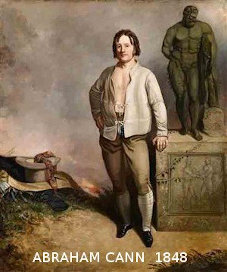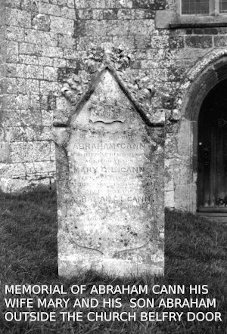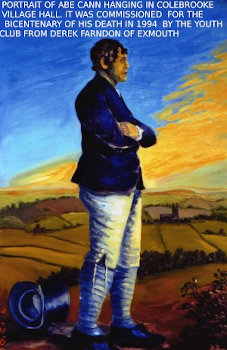Abraham Cann - Colebrooke's Champion

Abraham Cann 1848
Abraham was baptised privately at home a few days old at Snells Farm (Duck Street) Colebrooke December 4th 1794. Around 1800 the Cann family moved to Eastcoombehead Farm, Colebrooke, a bigger farm. Rene Stoneman of the Stoneman family who farmed Great Heale (which adjoins Eastcoombehead) whose mother was Abraham’s niece used to describe a route which Abraham would use to get to Colebrooke in his youth. It involved vaulting gates and running across the fields of Great Heale and Great Wotton to keep fit.
As the youngest member of a family whose chief hobby would appear to have been wrestling, young Abraham would have been continuously matching his skills against his elders. By the time he reached his early twenties, he was recognised as being the best wrestler in Devon. He was also according to reports of the time, “a good looking and most sporting contestant”.
It was these attributes which probably attracted the attention of Mary Gorwyn, the daughter of a local farmer and landowner Joseph Gorwyn and led to their wedding at Crediton in 1820. After their marriage, Abraham and Mary moved to Coltsfoot, a little farm further up the valley from Eastcoombehead. Within a month of their marriage, their first child, Mary Ann, was born. Sadly records show she was buried early the following year at Colebrooke aged nine weeks. Within twelve months, their second child William was born, and their third, Abraham was born in 1823. In 1824, Abraham gave up the farm to become the landlord of The Moreton Inn, St Thomas, Exeter, which itself was a recognised venue for wrestling. This period coincided with Abraham’s most remarkable years as a wrestler. He travelled widely through the country, to London and as far north as Leeds becoming known as “Champion of All England”, While Abraham and Mary were at The Moreton Inn, their son William died, and another son George was born. It would appear that this is the same George Cann aged 2, who was buried at Colebrooke February 8th 1829. Meanwhile, Abraham had moved from The Moreton Inn to The Woolpack Inn in Bartholomew Yard, Exeter, renaming it The Champions Arms. Another son William was born here but sadly died aged three months in February 1830 and was buried at Colebrooke. Later that year in September, Mary died aged just 30 years and was brought back to Colebrooke for burial. Her name is on Abrahams headstone in the churchyard to the west of the belfry door, but in fact, she is buried elsewhere in an unmarked grave with her children. After his sad losses Abraham took heavily to drink and gave up the Champions Arms, returning to live at Eastcoombehead.
The deaths of his two infant sons and his wife in quick succession affected Abraham badly. A newspaper article of 1831 soliciting help for him described him as “being reduced to poverty by illness and family affliction”. He gradually pulled himself together and with his surviving son Abraham, made his home back at Eastcoombehead again where his unmarried brothers Robert and William had continued to farm after the death of their parents and who were looked after by their long time housekeeper Susanna Heal. During this period he had also found work as a gamekeeper on a local estate. He continued to wrestle occasionally during the 1830s and apparently remained unbeaten. This gave rise in April 1841 to his supporters (of whom there were still many) issuing a challenge “To any man in Devonshire without regard for weight or inches to a fight for a prize of at least 20 sovereigns”. Unfortunately, Abraham had injured his shoulder, and the challenge was postponed until July 27th. The prize had by now risen to 100 sovereigns. This was scheduled to be Abraham Cann’s last wrestling match took place on Tuesday, July 27th 1841 some 25 years after he began his illustrious career. It ended after 48 minutes with Abraham unable to continue because of severe pain in his shoulder. Surgeons later confirmed that his collar bone was broken. Spectators left the field that day believing they had witnessed the last fight of a grand champion. However just over 12 months later, on August 10th 1842 Abraham was persuaded to return to the same ring to wrestle with the same opponent. This was a special event to be held as part of a wrestling tournament at the St Thomas field Exeter. Onlookers said that Abraham appeared in much better condition than when his shoulder was damaged the previous year.

Abraham Cann’s Headstone at Colebrooke
After a lengthy contest, Abraham defeated his much younger opponent. His jubilant supporters carried him around the field on their shoulders. There are no reports of Abraham ever contesting another fight. He continued to live and work on the family farm at Colebrooke but accepted numerous invitations to attend wrestling matches as a guest referee or a “trier” (similar to a second in boxing,) in tournaments all over the country. By 1860 his health was deteriorating, and he was described as being in “distressed circumstances.” Mr Langdon of The Bull Inn Exeter began a subscription fund for him, and it was soon evident that admirers of the old wrestler from all over the country had not forgotten him. Among the London subscribers was Lord Palmerston. . By October 1860 £200 had been collected, and it was decided to buy Abraham an annuity to be paid quarterly. After the granting of his annuity Abraham was able to continue living at Eastcoombehead in reasonable comfort with his brother William and their housekeeper Susanna Heal Abraham’s son, Abraham Jnr, a carpenter by trade had also come to live at Eastcoombehead. In January 1862 Abraham and his son had been to The Bell Inn Colebrooke to celebrate the new year. On returning home, Abraham went to bed while his son, who according to reports was “rather tipsy”, decided to sit in a chair a while and smoke his pipe. He fell asleep, and Abraham was later awoken by his son bursting into his bedroom with his clothes on fire. He was taken to hospital where reports say “he lingered in great pain”. He eventually died on March 6th. 1862 Poor Abraham was distraught. His wife and children had now all predeceased him, leaving no descendants. He never really recovered from this latest trauma and in April 1864, the following brief death announcement appeared in the Exeter Flying Post. “On April 7th at Colebrooke, near Crediton. Mr Abraham Cann (champion wrestler) in his 70th year.”
His death certificate showed his occupation was as “late innkeeper” - no mention of his wrestling prowess. Abraham was laid to rest at Colebrooke Monday, April 11th 1864, near the west door of the church, facing the green at Colebrooke where no doubt he would have begun his wrestling career. The ornamented headstone bearing the names of Abraham, his wife Mary and his son Abraham marks the grave. This memorial was provided by local farmer James Wreford and his brother Edwin of Youngs Farm Colebrooke. The original headstone had been found lying broken in 1876 less than twelve years after the erection.

Abraham Cann Painting by artist Derek Farndon
In 1994 Colebrooke village hall committee discussed ways of celebrating Abraham’s bicentenary. Mr John Crocker, who was also the leader of the youth club arranged for Exmouth artist Derek Farndon to produce a copy of the old print of Abraham which had been given to Colebrooke by the Stoneman family of Great Heale. This painting was achieved with a distant view of Colebrooke in the background. The painting was framed by Mr Crocker on behalf of the Youth Club in recognition of their 25th anniversary. He also arranged for local calligrapher Miss Ann Mansell to produce a copperplate copy of a brief history of Abraham which he also framed. These were hung on the front of the stage together with mention of the youth club’s involvement. They were unveiled by Mr Jonas Stoneman of Sampford Courtenay, Abraham’s great great great nephew at the annual harvest supper. To complete the celebrations Colebrooke Youth Club entered an Abraham Cann tableau in Crediton Carnival that year.
© Neville Enderson